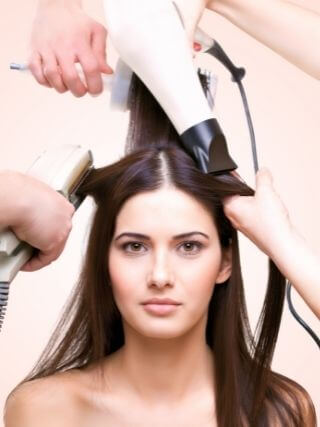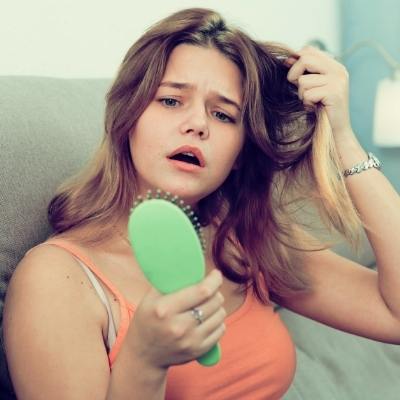Over-bleaching is one of the leading causes of hair breakage in the crown area. Aside from that, hair bleaches also include chemicals that can damage the hair from within. In this article, we will share the causes and 10 Fixes for Bleached Hair Breaking Off at Crown.
Table of Contents
What Causes Bleached hair to Break at Crown?
See increased hair breaking in the crown after bleaching, but don’t understand why the rest of your hair is doing well?
Hair breakage is more prevalent on the crown of your head than any other part of your hair. Pulling or tugging on the hair follicles causes them to become tense. These hairs are brittle and fragile because of how dry they are compared to the rest of your scalp.
The breakage is accelerated by bleaching. When you bleach your hair, you lose the natural oils that help to keep your hair healthy and moisturized. Bleaching chemicals have the potential to damage the cuticle scales, exposing the inner core of the hair and increasing the risk of moisture loss. This will leave your hair feeling porous and dry.
When cuticles are opened, hair becomes thinner, more delicate, and more likely to break. Bleached hair is brittle and crunchy because of this.
As a result, you may notice that your hair is falling out more in the crown area of your head. Using chemical processing like hair bleach on a regular basis should be avoided at all costs.
Other Possible Reasons:
- The hair tends to be coarser and brittler at the crown region, where it is most vulnerable to breakage. For relaxed and transitioning hair, this indicates a more pronounced and thinner separating line.
- When relaxing hair, most individuals divide their hair into four sections and apply the relaxer from the center outward. When you rest, the first part gets the most processing.
- Your heat tools are frazzling and breaking the crown region, which is frequently the coarsest and driest part of the crown.
- When moisturizing or conditioning, you are neglecting the crown region.
Check the article on What to do right after bleaching hair
10 Cause and Fixes for Bleached Hair Breaking Off at Crown
By lifting the cuticles of the hair, the hair bleach weakens the hair’s exterior structure, leaving the inner protein core exposed to damage. This can happen over time as the bleach’s chemicals work to lessen the color. This is why hair that has been overly bleached is more prone to breakage and split-ends. This especially affects the crown area as it’s the weakest and first to break.
Cause 1: Insufficient Protein or/and Moisture

The fact that your hair has broken suggests that the underlying structure of your hair is flimsy. Weak, brittle natural hair is frequently caused by a deficiency in moisture or protein. It’s also possible that it’s a mix of the two. You may have to increase the frequency with which you condition, apply protein treatments, and/or remoisturize your hair. Those developed to restore damaged hair to an appropriate protein-moisture balance should be the emphasis of conditioner selections.
Apply a liquid moisturizer, seal with oil, and protect with cream to your hair to keep it healthy. If your hair is fine, this moisturizing approach may be too heavy for you. If that’s the case, only apply to the backside.
You may also use a moisturizing shampoo to help restore the hair’s moisture. We need to double-check the contents beforehand before taking it up. When choosing a moisturizer, look for one that has a high concentration of Vitamin E as well as amino acids and silicones. These ingredients help to strengthen hair and reduce breakage. Use a small amount of conditioner no more than twice each week. If you have greasy, sticky hair and must shampoo every day, at the absolute least, allow yourself a day’s break between shampoos.
Again, moisture is critical for a healthy scalp and hair. Make sure you’re getting lots of fluids each day. When the weather is dry, try utilizing a humidifier in your home, bedroom, or workplace to help prevent your surroundings from being overly dried out. Using a humidifier during the winter months can help prevent your home from being too dry from the heat drying up the air.
Cause 2: Too much Hair Styling or Processing
Excessive strain from hairstyles is another major cause of breaking at the crown and hairline. If you have a protective style like a weave or a natural look, make sure it’s not too tight. Constant strain and manipulation of the same regions of the scalp can lead to hair breakage.
Manipulating your hair in any way, shape, or form is considered manipulation. If you’re continuously breaking your natural hair at the top of your head to get more volume, you’re putting your hair and your scalp at risk. If you’re using a comb, consider using a wider toothed one that can take in denser roots instead of the pick.
Clips and ponytails should be alternatively placed in different spots to give your scalp the necessary rest. Make sure your buns and ponytails aren’t too tight when wearing them.
Instead of keeping your hair in a tight bun or braids all the time, experiment with wearing it down when you have the opportunity. If you can’t let your hair down, choose a different haircut that doesn’t pull as much or loosen up your normal one. If at all possible, for the sake of your scalp health, refrain from pulling your hair too tight.
Cause 3: Uneven Application of Haircare Products
Uneven distribution of products in bleached hair is a typical error. If you’re putting products to your hair, split it off into smaller parts so that all of your strands get their fair share of moisture and/or protein from the roots to the ends. As much as we want to focus on the tips of our hair, the roots are just as prone to breakage as the ends. Using hydrating and easy-to-distribute style solutions from roots to ends is also critical.
Cause 4: Not Trimming your Hair when Needed
If the thinning/broken hair at the top of your head is uneven, you may want to consider getting it trimmed. It’s pointless to keep damaged or split-ended hairs. Your hair will continue to grow, but the ends will break as they go up the hair shaft. Trim the portion to the point where it is at its healthiest. After some time, it will be stronger and healthier than before.
Breakage may be quickly eliminated by cutting your hair short. Consult with a hairstylist and have a custom trim to get rid of the majority of the damaged ends. If you use a hairdryer after every shower and spend a lot of time in the sun, you should get your hair trimmed every eight weeks. Otherwise, the split will continue to travel up your hair shaft, resulting in breakage at the crown.
Cause 5: Too Much Heat

When it comes to hair damage, the top of our heads is the most vulnerable place in the head. Hot air from blow-drying or being in the sun is the two greatest culprits. A lower heat setting and/or checking that hair roots aren’t becoming too hot when blow-drying may be necessary for those who often use blow dryers on their hair.
Blow dryers and other high-heat styling equipment can dry out your scalp and damage your hair. The hot air may dry out your head very quickly. If you use blow dryers or other heat styling equipment on your hair, use the cold setting instead of the highest heat setting. You should also aim to utilize these tools as little as possible or keep them for rare occasions exclusively.
Hot showers, in addition to styling products, can dry out your scalp. Although I’m a sucker for a hot shower, you might want to think about bringing the temperature down a notch or two. I’m not advocating taking cold showers, but do what you feel comfortable with!
Cause 6: Over Washing
If you have oily skin, you are more likely to have excessive natural oil production in your scalp as well. As a result, you may feel compelled to wash your hair more frequently than is really necessary.
Even if you have greasy hair, you can get away with washing it once a day, but you shouldn’t be doing it more than that. Extremely dry hair, on the other hand, could require only a weekly shampooing.
Also, wash your hair carefully, paying special attention to the scalp, and apply conditioner evenly from the ends to the roots of your hair.

Cause 7: Incorrect Combing or Brushing
The popular saying “100 strokes a day is good for your hair” may not hold true in every situation and can actually harm your hair at times.
Professional stylists suggest using a comb or brush only at the time of styling your hair. Use wide-tooth combs to avoid tangling. Avoid using plastic bristles and only use a brush when your hair is completely dry. As an alternative, make use of a brush with natural fibers.
Moisturize the crown region before using a comb. Hair that is completely dry is more prone to breaking. Use a small, soft comb to carefully remove any loose hairs.
Check the article on 11 Types of Combs and Hairbrushes and their Purpose
Cause 8: Towel Drying
After a shower, wrapping your hair up in a towel may seem like the natural thing to do, but this may lead to significant tangling and breaking difficulties. Instead, use a microfiber towel, an old, soft T-shirt, or a paper towel, which are all absorbent and much kinder to your hair than a conventional towel.
Cause 9: Cotton Pillowcase
Because of the friction created between your hair and the fabric as you sleep, your favorite cotton pillowcase may be making your hair break off more frequently than normal. Instead, get a satin or silk pillowcase to prevent your sheets from snagging as you sleep.
Cotton, which is commonly found in clothing and bedding, may be harsh on your hair, resulting in knots, dryness, and other problems. Swap out some of your cotton items for satin-lined ones.
Many ladies with bleached hair choose to sleep in bonnets, do-rags, or silk wraps in addition to pillows. Soft, additional layers protect your hair from friction and strain caused by tossing and turning during the night.
Even if you don’t consider yourself an active sleeper, the normal motions we make when sleeping may cause stress to our hair, even if we’re not aware of it.
Cause 10: Lack of Deep Conditioning
Dryness and lack of moisture in the hair and scalp can lead to a lot of breakage in the crown area. As a result, the hair on the crown of your head tends to be dryer and coarser than the rest of your hair.
Bleaching your hair might lead to damage in the long term. And in these situations, conditioner is the best option, but not the ordinary kind. This problem of breakage will not be resolved by using a normal conditioner. So, before you go to bed, use a deep conditioner that you can find at the store. Before going to bed, cover your hair with a plastic hair cover to prevent it from drying out the conditioner.
Deep conditioning or protein treatments can help hydrate and rejuvenate the crown region if it is feeling dry.
When it comes to hair care, many individuals focus just on the ends and ignore the crown. When using moisturizing products, don’t forget about the crown of your head when applying them.
If your hair is dry in that region, you may want to apply in larger quantities or a more specialized product. Using hydrating mists can also keep your hair moisturized all day.
Summary
Hair loss at the top of the head can be caused by a variety of factors.
Most underlying reasons can be resolved by changing certain daily habits and lifestyles. If your hair breakage persists despite modifying these habits of hair care routine, you should consult a doctor to rule out any underlying medical conditions.
Hair breakage may be prevented by cutting your hair regularly, using deep conditioners, and following the other advice listed above.
Hair loss at the crown of the head is a problem that will take time to resolve. You’ll be able to get your healthy hair back with patience and care.
Give your hair a break from chemical treatments like bleach if you can. These harsh chemicals alter your hair’s natural chemical structure, making it more brittle and prone to breakage. If you decide to continue with any of these procedures, be sure they are performed by a licensed beautician.
Do you know that you can naturally bleach your hair by simple sun exposure? Check the article on All About Sun Bleach Hair – The Science

Creative, versatile, and passionate about her craft, Rupa Das is a well-recognized name in the world of fashion and makeup! This is a woman who has been in the fashion and makeup industry for 24 years and is still one of the leading international makeup artist in the circuit! She has worked in big brands like Lakme, Green Trends, Colors and transitioned to become a Beauty (Hair & Skin) Trainer.